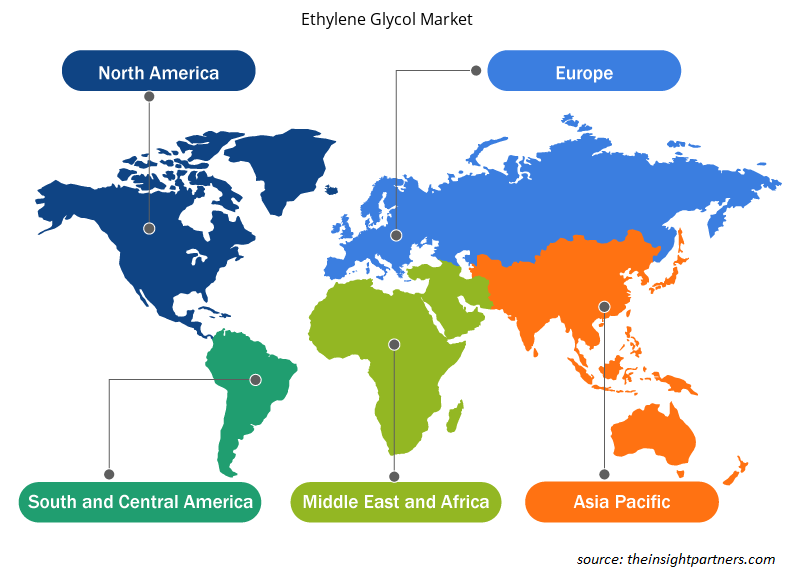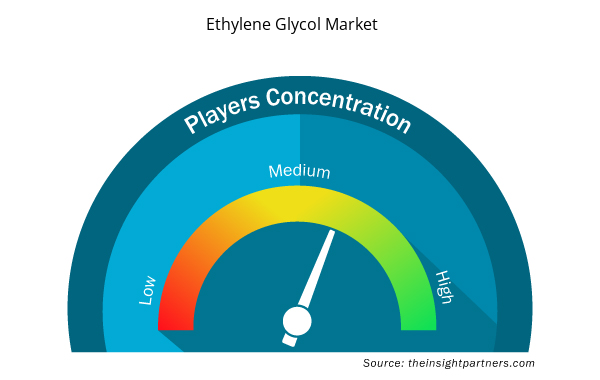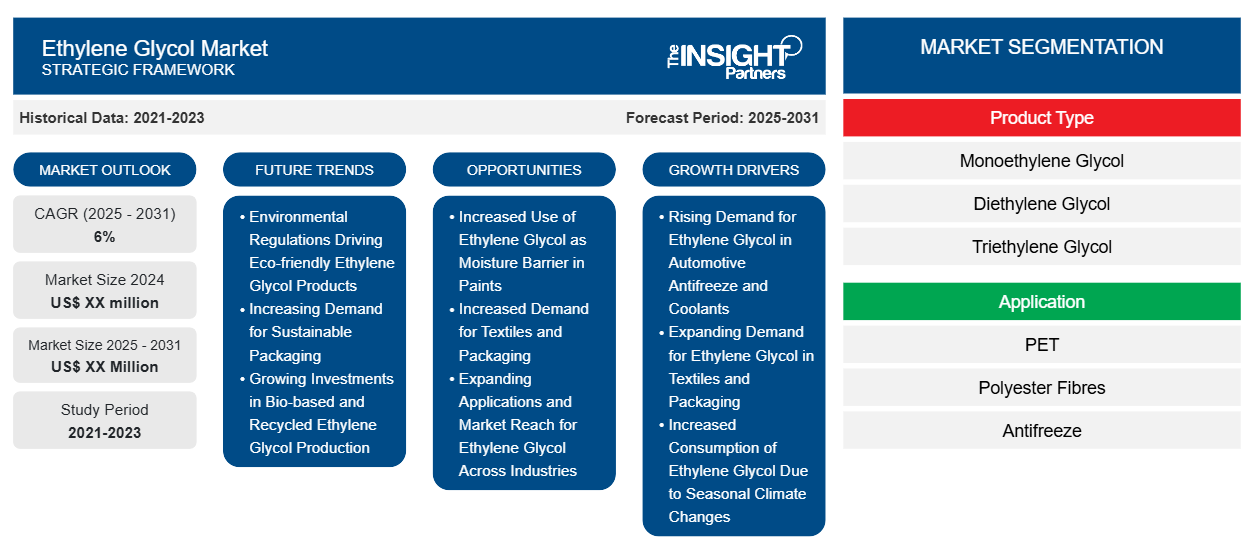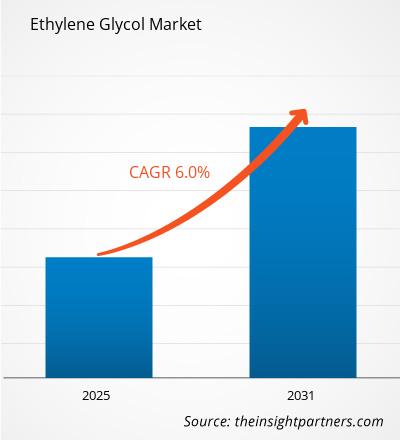Der Ethylenglykol-Markt wird voraussichtlich von 2024 bis 2031 eine durchschnittliche jährliche Wachstumsrate (CAGR) von 6 % verzeichnen, wobei die Marktgröße von XX Millionen US-Dollar im Jahr 2024 auf XX Millionen US-Dollar im Jahr 2031 wachsen wird.
Der Ethylenglykolmarkt umfasst Analysen nach Produkttyp (Monoethylenglykol (MEG), Diethylenglykol (DEG), Triethylenglykol (TEG)); Anwendung (PET, Polyesterfasern, Frostschutzmittel, Sonstiges) und Geografie (Nordamerika, Europa, Asien-Pazifik, Naher Osten und Afrika sowie Süd- und Mittelamerika). Ethylenglykol ist eine süß schmeckende, farblose Flüssigkeit, die aus Ethylenoxid hergestellt wird. Bei der Herstellung von Ethylenglykol aus Ethylenoxid entstehen Diethylenglykol (DEG) und Triethylenglykol (TEG). Ethylenglykol wird hauptsächlich bei der Herstellung von Polyesterfasern, PET-Flaschenharzen und Folien verwendet.
Zweck des Berichts
Der Bericht Ethylenglykolmarkt von The Insight Partners soll die aktuelle Situation und das zukünftige Wachstum sowie die wichtigsten treibenden Faktoren, Herausforderungen und Chancen beschreiben. Dies wird verschiedenen Geschäftspartnern Einblicke geben, wie zum Beispiel:
- Technologieanbieter/-hersteller: Um die sich entwickelnde Marktdynamik zu verstehen und die potenziellen Wachstumschancen zu kennen, damit sie fundierte strategische Entscheidungen treffen können.
- Investoren: Durchführung einer umfassenden Trendanalyse hinsichtlich der Marktwachstumsrate, der finanziellen Marktprognosen und der Chancen entlang der Wertschöpfungskette.
- Regulierungsbehörden: Zur Regulierung von Richtlinien und Überwachungsaktivitäten auf dem Markt mit dem Ziel, Missbrauch zu minimieren, das Vertrauen der Anleger zu bewahren und die Integrität und Stabilität des Marktes aufrechtzuerhalten.
Ethylenglykol Marktsegmentierung
Produkttyp
- Monoethylenglykol
- Diethylenglykol
- Triethylenglykol
Anwendung
- HAUSTIER
- Polyesterfasern
- Frostschutzmittel
- Sonstiges
Passen Sie diesen Bericht Ihren Anforderungen an
Sie erhalten kostenlos individuelle Anpassungen an jedem Bericht, einschließlich Teilen dieses Berichts oder einer Analyse auf Länderebene, eines Excel-Datenpakets sowie tolle Angebote und Rabatte für Start-ups und Universitäten.
- Holen Sie sich die wichtigsten Markttrends aus diesem Bericht.Dieses KOSTENLOSE Beispiel umfasst eine Datenanalyse von Markttrends bis hin zu Schätzungen und Prognosen.
Wachstumstreiber auf dem Ethylenglykolmarkt
- Steigende Nachfrage nach Ethylenglykol in Frostschutzmitteln und Kühlmitteln für Kraftfahrzeuge: Ethylenglykol wird häufig in der Formulierung von Frostschutzmitteln und Kühlmitteln für Kraftfahrzeuge verwendet. Mit der zunehmenden weltweiten Produktion und dem zunehmenden Verkauf von Automobilmaschinen wird die Nachfrage nach Ethylenglykol zur Gewährleistung der Fahrzeugleistung und -sicherheit in den kommenden Jahren stark ansteigen.
- Steigende Nachfrage nach Ethylenglykol in der Textil- und Verpackungsindustrie: Ethylenglykol ist einer der wichtigsten Rohstoffe für die Herstellung von Polyethylenterephthalat, einem führenden Material in der Textil- und Verpackungsindustrie. Die wichtigsten Endanwendungen von Ethylenglykol sind in erster Linie die Textil- und Konsumgütermärkte, insbesondere Polyesterfasern und PET-Flaschen.
- Erhöhter Verbrauch von Ethylenglykol aufgrund saisonaler Klimaveränderungen: Eine Veränderung der klimatischen Bedingungen von Saison zu Saison erfordert einen höheren Verbrauch von Frostschutzmitteln sowohl zu Hause als auch in der Industrie. Daher besteht eine hohe Nachfrage nach Ethylenglykol als einem der Hauptbestandteile von Frostschutzmitteln, um maximalen Schutz vor dem Einfrieren sowie eine gute Kühlleistung zu erreichen.
Zukünftige Trends auf dem Ethylenglykolmarkt
- Umweltauflagen fördern umweltfreundliche Ethylenglykolprodukte: Strengere Umweltauflagen erzwingen die Entwicklung noch umweltfreundlicherer Produkte. Da Ethylenglykol biologisch abbaubar und viel weniger giftig als andere Produkte ist, bietet es einen Vorteil für Unternehmen, die grüne Initiativen umsetzen und ihren ökologischen Fußabdruck verringern möchten.
- Steigende Nachfrage nach nachhaltiger Verpackung: Die Nachfrage nach Polyethylenterephthalat wird entsprechend den Wachstumsraten der Getränke- und Verpackungsindustrie steigen. Dies wiederum wird den Verbrauch von Ethylenglykol direkt erhöhen. Immer mehr Unternehmen werden nach nachhaltigen Verpackungslösungen suchen und so das Wachstum in diesem Markt fördern.
- Wachsende Investitionen in die Produktion von biobasiertem und recyceltem Ethylenglykol: Das Wachstum der Verbraucher und die Vorschriften zur Nachhaltigkeit werden die Haupttreiber für die Nachfrage nach biobasiertem und recyceltem Ethylenglykol sein. Für den Hersteller werden die globalen Anforderungen an Nachhaltigkeit und die Verbrauchernachfrage weiterhin hohe Investitionen in umweltfreundlichere Produktionsprozesse und Alternativen für biobasiertes und recyceltes Ethylenglykol nach sich ziehen.
Marktchancen für Ethylenglykol
- Zunehmende Verwendung von Ethylenglykol als Feuchtigkeitsbarriere in Farben: Neben seiner Verwendung als Frostschutzmittel für Beton wird Ethylenglykol auch in der Bauindustrie häufig eingesetzt. Es wird auch als Feuchtigkeitsbarriere in Farben verwendet. So laufen beispielsweise der Ausbau der Infrastruktur und die Stadterweiterung noch auf Hochtouren. Allein diese Faktoren werden voraussichtlich zu einer weiteren Zunahme der Verwendung von Ethylenglykol in Baumaterialien führen.
- Erhöhte Nachfrage nach Textilien und Verpackungen: Bevölkerungswachstum und zunehmende Urbanisierung steigern die Nachfrage nach Konsumgütern, darunter Textilien und verpackte Produkte. Dies bietet daher eine Chance für Ethylenglykol bei der Herstellung von Materialien, die bei veränderten Verbraucherpräferenzen Verwendung finden.
- Erweiterte Anwendungsgebiete und Marktreichweite für Ethylenglykol in allen Branchen: Durch Innovationen in der Produktionstechnologie wird die Herstellung von Ethylenglykol effizienter. Durch die Verbesserung des Prozesses und die Senkung der Kosten wird Ethylenglykol noch verfügbarer und bietet mehr Anwendungsgebiete und eine noch größere Marktreichweite in verschiedenen Branchen.
Regionale Einblicke in den Ethylenglykolmarkt
Die regionalen Trends und Faktoren, die den Ethylenglykolmarkt während des Prognosezeitraums beeinflussen, wurden von den Analysten von Insight Partners ausführlich erläutert. In diesem Abschnitt werden auch die Ethylenglykolmarktsegmente und die Geografie in Nordamerika, Europa, im asiatisch-pazifischen Raum, im Nahen Osten und Afrika sowie in Süd- und Mittelamerika erörtert.

- Holen Sie sich die regionalspezifischen Daten für den Ethylenglykolmarkt
Umfang des Ethylenglykol-Marktberichts
| Berichtsattribut | Details |
|---|---|
| Marktgröße im Jahr 2024 | XX Millionen US-Dollar |
| Marktgröße bis 2031 | XX Millionen US-Dollar |
| Globale CAGR (2024 - 2031) | 6 % |
| Historische Daten | 2021-2023 |
| Prognosezeitraum | 2025–2031 |
| Abgedeckte Segmente | Nach Produkttyp
|
| Abgedeckte Regionen und Länder | Nordamerika
|
| Marktführer und wichtige Unternehmensprofile |
|
Dichte der Marktteilnehmer für Ethylenglykol: Auswirkungen auf die Geschäftsdynamik verstehen
Der Markt für Ethylenglykol wächst rasant, angetrieben durch die steigende Nachfrage der Endverbraucher aufgrund von Faktoren wie sich entwickelnden Verbraucherpräferenzen, technologischen Fortschritten und einem größeren Bewusstsein für die Vorteile des Produkts. Mit steigender Nachfrage erweitern Unternehmen ihr Angebot, entwickeln Innovationen, um die Bedürfnisse der Verbraucher zu erfüllen, und nutzen neue Trends, was das Marktwachstum weiter ankurbelt.
Die Marktteilnehmerdichte bezieht sich auf die Verteilung von Firmen oder Unternehmen, die in einem bestimmten Markt oder einer bestimmten Branche tätig sind. Sie gibt an, wie viele Wettbewerber (Marktteilnehmer) in einem bestimmten Marktraum im Verhältnis zu seiner Größe oder seinem gesamten Marktwert präsent sind.
Die wichtigsten auf dem Ethylenglykolmarkt tätigen Unternehmen sind:
- Dow Chemical Company
- ExxonMobil
- Formosa Plastics Gruppe
- Honam Petrochemie
- Ineos
Haftungsausschluss : Die oben aufgeführten Unternehmen sind nicht in einer bestimmten Reihenfolge aufgeführt.

- Überblick über die wichtigsten Akteure auf dem Ethylenglykol-Markt
Wichtige Verkaufsargumente
- Umfassende Abdeckung: Der Bericht deckt die Analyse von Produkten, Dienstleistungen, Typen und Endbenutzern des Ethylenglykol-Marktes umfassend ab und bietet einen ganzheitlichen Überblick.
- Expertenanalyse: Der Bericht basiert auf dem umfassenden Verständnis von Branchenexperten und Analysten.
- Aktuelle Informationen: Der Bericht stellt durch die Abdeckung aktueller Informationen und Datentrends Geschäftsrelevanz sicher.
- Anpassungsoptionen: Dieser Bericht kann angepasst werden, um den spezifischen Kundenanforderungen gerecht zu werden und die Geschäftsstrategien optimal anzupassen.
Der Forschungsbericht zum Ethylenglykolmarkt kann daher dabei helfen, die Branchensituation und Wachstumsaussichten zu entschlüsseln und zu verstehen. Obwohl es einige berechtigte Bedenken geben kann, überwiegen die allgemeinen Vorteile dieses Berichts tendenziell die Nachteile.
- Historische Analyse (2 Jahre), Basisjahr, Prognose (7 Jahre) mit CAGR
- PEST- und SWOT-Analyse
- Marktgröße Wert/Volumen – Global, Regional, Land
- Branche und Wettbewerbsumfeld
- Excel-Datensatz



Report Coverage
Revenue forecast, Company Analysis, Industry landscape, Growth factors, and Trends

Segment Covered
This text is related
to segments covered.

Regional Scope
North America, Europe, Asia Pacific, Middle East & Africa, South & Central America

Country Scope
This text is related
to country scope.
Häufig gestellte Fragen
The growing demand the demand for bio-based and recycled ethylene glycol is an emerging trend in the market.
The Asia Pacific market is expected to account for the highest CAGR during the forecast period owing to the growing construction industry in the region.
The MEG product segment accounted for the largest market share in 2023.
The growing demand from formulation of vehicle antifreeze and coolants is a key driver in the market.
Dow Chemical Company, ExxonMobil, Formosa Plastics Group, Honam Petrochemicals, Ineos, Nouryon, Reliance Industries Limited, SABIC, Shell Chemical, and Sinopec are some of the key players operating in the market.
The Ethylene Glycol Market is estimated to witness a CAGR of 6% from 2023 to 2031
Trends and growth analysis reports related to Chemicals and Materials : READ MORE..
1.Dow Chemical Company
2.ExxonMobil
3.Formosa Plastics Group
4.Honam Petrochemicals
5.Ineos
6.Nouryon
7.Reliance Industries Limited
8.SABIC
9.Shell Chemical
10.Sinopec
The Insight Partners performs research in 4 major stages: Data Collection & Secondary Research, Primary Research, Data Analysis and Data Triangulation & Final Review.
- Data Collection and Secondary Research:
As a market research and consulting firm operating from a decade, we have published and advised several client across the globe. First step for any study will start with an assessment of currently available data and insights from existing reports. Further, historical and current market information is collected from Investor Presentations, Annual Reports, SEC Filings, etc., and other information related to company’s performance and market positioning are gathered from Paid Databases (Factiva, Hoovers, and Reuters) and various other publications available in public domain.
Several associations trade associates, technical forums, institutes, societies and organization are accessed to gain technical as well as market related insights through their publications such as research papers, blogs and press releases related to the studies are referred to get cues about the market. Further, white papers, journals, magazines, and other news articles published in last 3 years are scrutinized and analyzed to understand the current market trends.
- Primary Research:
The primarily interview analysis comprise of data obtained from industry participants interview and answers to survey questions gathered by in-house primary team.
For primary research, interviews are conducted with industry experts/CEOs/Marketing Managers/VPs/Subject Matter Experts from both demand and supply side to get a 360-degree view of the market. The primary team conducts several interviews based on the complexity of the markets to understand the various market trends and dynamics which makes research more credible and precise.
A typical research interview fulfils the following functions:
- Provides first-hand information on the market size, market trends, growth trends, competitive landscape, and outlook
- Validates and strengthens in-house secondary research findings
- Develops the analysis team’s expertise and market understanding
Primary research involves email interactions and telephone interviews for each market, category, segment, and sub-segment across geographies. The participants who typically take part in such a process include, but are not limited to:
- Industry participants: VPs, business development managers, market intelligence managers and national sales managers
- Outside experts: Valuation experts, research analysts and key opinion leaders specializing in the electronics and semiconductor industry.
Below is the breakup of our primary respondents by company, designation, and region:

Once we receive the confirmation from primary research sources or primary respondents, we finalize the base year market estimation and forecast the data as per the macroeconomic and microeconomic factors assessed during data collection.
- Data Analysis:
Once data is validated through both secondary as well as primary respondents, we finalize the market estimations by hypothesis formulation and factor analysis at regional and country level.
- Macro-Economic Factor Analysis:
We analyse macroeconomic indicators such the gross domestic product (GDP), increase in the demand for goods and services across industries, technological advancement, regional economic growth, governmental policies, the influence of COVID-19, PEST analysis, and other aspects. This analysis aids in setting benchmarks for various nations/regions and approximating market splits. Additionally, the general trend of the aforementioned components aid in determining the market's development possibilities.
- Country Level Data:
Various factors that are especially aligned to the country are taken into account to determine the market size for a certain area and country, including the presence of vendors, such as headquarters and offices, the country's GDP, demand patterns, and industry growth. To comprehend the market dynamics for the nation, a number of growth variables, inhibitors, application areas, and current market trends are researched. The aforementioned elements aid in determining the country's overall market's growth potential.
- Company Profile:
The “Table of Contents” is formulated by listing and analyzing more than 25 - 30 companies operating in the market ecosystem across geographies. However, we profile only 10 companies as a standard practice in our syndicate reports. These 10 companies comprise leading, emerging, and regional players. Nonetheless, our analysis is not restricted to the 10 listed companies, we also analyze other companies present in the market to develop a holistic view and understand the prevailing trends. The “Company Profiles” section in the report covers key facts, business description, products & services, financial information, SWOT analysis, and key developments. The financial information presented is extracted from the annual reports and official documents of the publicly listed companies. Upon collecting the information for the sections of respective companies, we verify them via various primary sources and then compile the data in respective company profiles. The company level information helps us in deriving the base number as well as in forecasting the market size.
- Developing Base Number:
Aggregation of sales statistics (2020-2022) and macro-economic factor, and other secondary and primary research insights are utilized to arrive at base number and related market shares for 2022. The data gaps are identified in this step and relevant market data is analyzed, collected from paid primary interviews or databases. On finalizing the base year market size, forecasts are developed on the basis of macro-economic, industry and market growth factors and company level analysis.
- Data Triangulation and Final Review:
The market findings and base year market size calculations are validated from supply as well as demand side. Demand side validations are based on macro-economic factor analysis and benchmarks for respective regions and countries. In case of supply side validations, revenues of major companies are estimated (in case not available) based on industry benchmark, approximate number of employees, product portfolio, and primary interviews revenues are gathered. Further revenue from target product/service segment is assessed to avoid overshooting of market statistics. In case of heavy deviations between supply and demand side values, all thes steps are repeated to achieve synchronization.
We follow an iterative model, wherein we share our research findings with Subject Matter Experts (SME’s) and Key Opinion Leaders (KOLs) until consensus view of the market is not formulated – this model negates any drastic deviation in the opinions of experts. Only validated and universally acceptable research findings are quoted in our reports.
We have important check points that we use to validate our research findings – which we call – data triangulation, where we validate the information, we generate from secondary sources with primary interviews and then we re-validate with our internal data bases and Subject matter experts. This comprehensive model enables us to deliver high quality, reliable data in shortest possible time.


 Holen Sie sich ein kostenloses Muster für diesen Bericht
Holen Sie sich ein kostenloses Muster für diesen Bericht